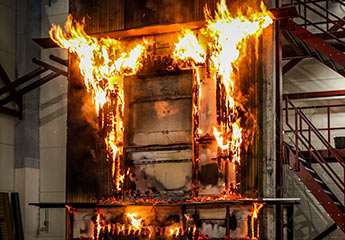This PhD project aims to develop a model describing the mobility and leaching of fire retardants in wood, driven by moisture transport.
The use of wood in construction has the potential to reduce the CO₂ footprint of the building industry. However, fire risk remains a barrier to the broader application of wood, especially in outdoor settings. Fire retardants are applied to wood to enhance its fire safety. Unfortunately, these retardants tend to leach out when exposed to wind, weather, and rain, which over time reduces their effectiveness. To predict the long-term fire performance of wood facades, it is crucial to understand and model how fire retardants leach from wood due to rain exposure.
The project has three main objectives:
- Development of a Material-Level Model: The first objective is to characterize how moisture interacts with wood and fire retardants, leading to the leaching process. This includes understanding the material-level factors that influence moisture transport and the movement of fire retardants within the wood structure.
- Translation from Material to Building Scale: The second objective is to apply the results from the material-level model to predict how fire retardants behave in wood facades in real buildings. This phase will consider external factors such as weather conditions and building design.
- Validation of Models and Characterization of Fire Performance: The final objective is to validate both the material-level and building-scale models through a combination of laboratory tests and large-scale experiments.
The results of this project will provide valuable data for both researchers and the construction industry, helping to document and predict the long-term fire safety of wood in buildings. By addressing the challenges of fire retardant leaching, the project contributes to the overall goal of increasing the use of sustainable wood materials in construction.
First Project Milestone
The first milestone of the project—model development—involves gathering detailed information on how wood properties affect the impregnation process and retention of fire retardants. Water samples are taken during the leaching process and analyzed using Inductively Coupled Plasma Mass Spectrometry (ICP-MS) to obtain precise data on leaching rates.
Preliminary small-scale experiments are set up to observe fundamental trends, and we are moving toward more complex experiments that introduce multiple variables. These tests will provide insights into how moisture dynamics affect fire retardants in wood under various experimental setups. The insights will form the foundation for the model's development and the subsequent stages of the project.

